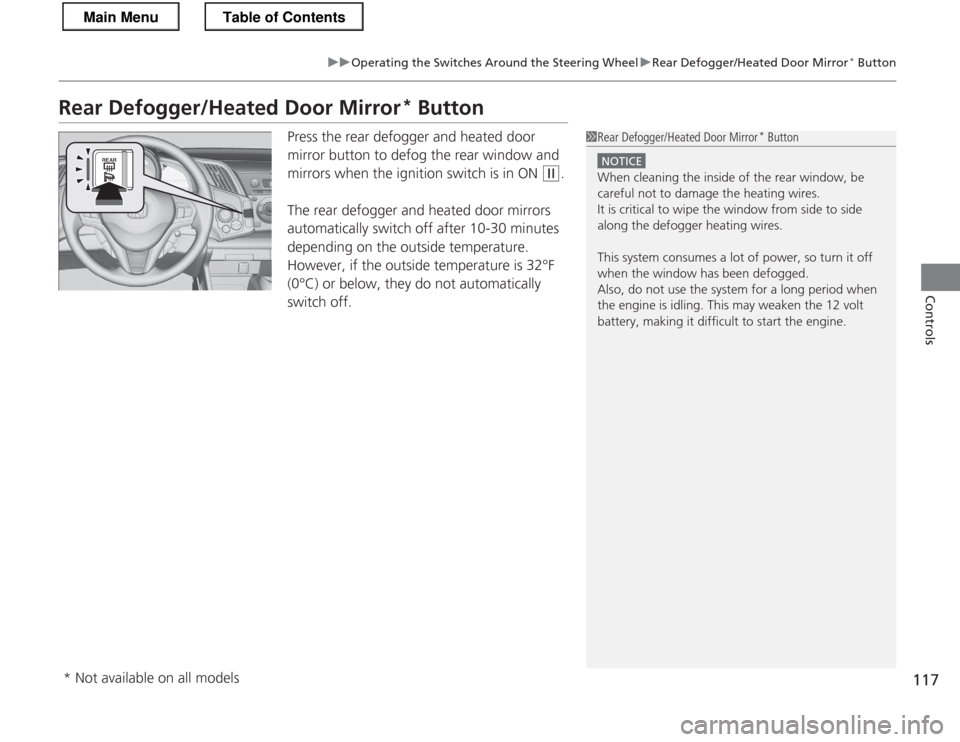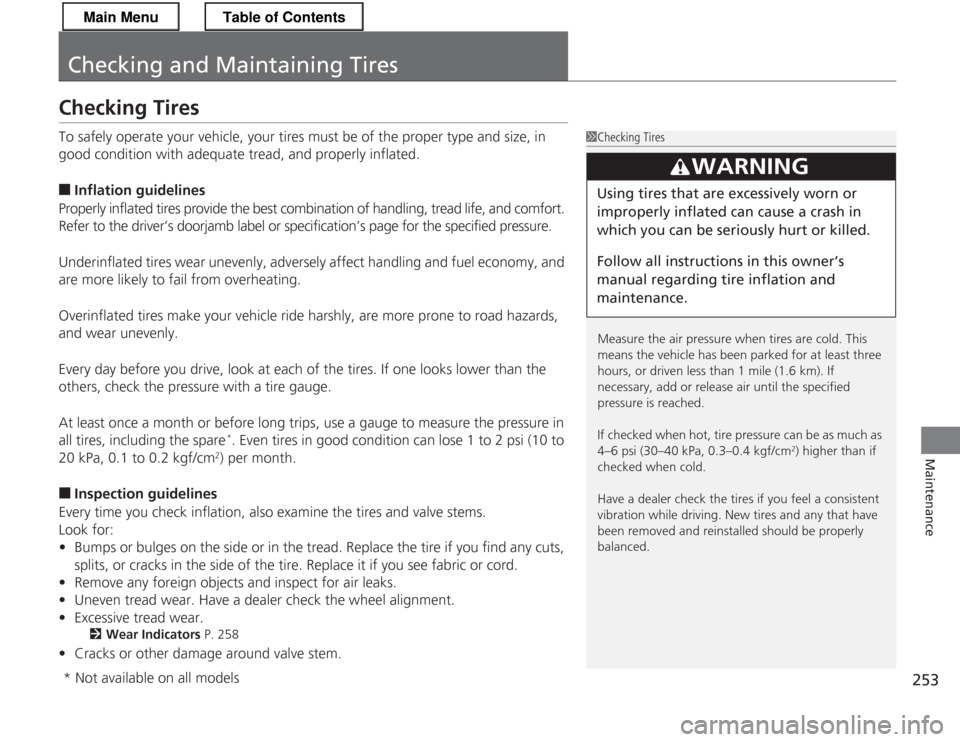2013 HONDA CR-Z heating
[x] Cancel search: heatingPage 23 of 325

22
Quick Reference Guide
Handling the Unexpected (P269)
Flat Tire (P271)
● Park in a safe place and repair the flat tire
using the temporary tire repair kit.
● Park in a safe place and replace the flat
tire with the compact spare tire in the
cargo area.
Indicators Come On
(P292) ● Identify the indicator and consult the
owner's manual.
Models with an optional compact spare tire
Engine Won't Start (P286)
● If the battery is dead, jump start using a booster battery.
Blown Fuse (P297)
● Check for a blown fuse if an electrical device does not operate.Overheating (P290)
● Park in a safe location. If you do not see
steam under the hood, open the hood, and let the engine cool down.
Emergency Towing (P301)
● Call a professional towing service if you need to tow your vehicle.
Main Menu
Page 73 of 325

72
uuIndicatorsu
Instrument Panel
IndicatorNameOn/BlinkingExplanationMessage
High
Temperature
Indicator
●Comes on for a few seconds when
you turn the ignition switch to ON
(w .
● Blinks when the engine coolant temperature goes up, and stays
on if the temperature continues to rise.
● Blinks while driving - Drive slowly to
prevent overheating.
● Stays on while driving - Immediately
stop in a safe place and allow the engine to cool. 2Overheating P. 290
IMA System
Indicator
● Comes on for a few seconds when
you turn the ignition switch to ON
(w .
● Comes on if there is a problem
with the IMA system.
● Remains on or does not come on at all - Avoid high speed driving and have
the vehicle checked by a dealer as soon as possible. 2If the IMA Indicator Comes On
P. 296
System Message
Indicator
● Comes on for a few seconds when
you turn the ignition switch to ON
(w , then goes off.
● Comes on along with a beep
when a problem is detected. A
system message on the multi-information display appears at the
same time.
● While the indicator is on, press the
(information) button to see the
message again.
● Refer to the Indicators information in this
chapter when a system message appears
on the multi-information display. Take
the appropriate action for the message.
● The multi-information display does not
return to the normal screen unless the
warning is canceled, or the button is pressed.
—
Main MenuTable of Contents
Page 118 of 325

117
uuOperating the Switches Around the Steering WheeluRear Defogger/Heated Door Mirror*
Button
Controls
Rear Defogger/Heated Door Mirror *
Button
Press the rear defogger and heated door
mirror button to defog the rear window and
mirrors when the ignition switch is in ON
(w .
The rear defogger and heated door mirrors
automatically switch off after 10-30 minutes
depending on the outside temperature.
However, if the outside temperature is 32°F
(0°C) or below, they do not automatically switch off.
1Rear Defogger/Heated Door Mirror *
Button
NOTICE
When cleaning the inside of the rear window, be
careful not to damage the heating wires.
It is critical to wipe the window from side to side
along the defogger heating wires.
This system consumes a lot of power, so turn it off
when the window has been defogged.
Also, do not use the system for a long period when
the engine is idling. This may weaken the 12 volt
battery, making it difficult to start the engine.
* Not available on all models
Main MenuTable of Contents
Page 254 of 325

253
Maintenance
Checking and Maintaining Tires
Checking Tires
To safely operate your vehicle, your tires must be of the proper type and size, in
good condition with adequate tread, and properly inflated. ■Inflation guidelines
Properly inflated tires provide the best co mbination of handling, tread life, and comfort.
Refer to the driver’s doorjamb label or specification’s page for the specified pressure.
Underinflated tires wear unevenly, adversely affect handling and fuel economy, and
are more likely to fail from overheating.
Overinflated tires make your vehicle ride harshly, are more prone to road hazards, and wear unevenly.
Every day before you drive, look at each of the tires. If one looks lower than the
others, check the pressure with a tire gauge.
At least once a month or before long trips, use a gauge to measure the pressure in
all tires, including the spare *
. Even tires in good condition can lose 1 to 2 psi (10 to
20 kPa, 0.1 to 0.2 kgf/cm 2
) per month.
■ Inspection guidelines
Every time you check inflation, also examine the tires and valve stems. Look for:• Bumps or bulges on the side or in the tread. Replace the tire if you find any cuts,
splits, or cracks in the side of the tire. Replace it if you see fabric or cord.
• Remove any foreign objects and inspect for air leaks.
• Uneven tread wear. Have a dealer check the wheel alignment.
• Excessive tread wear.
2 Wear Indicators P. 258
• Cracks or other damage around valve stem.
1Checking Tires
Measure the air pressure when tires are cold. This
means the vehicle has been par ked for at least three
hours, or driven less than 1 mile (1.6 km). If
necessary, add or release air until the specified pressure is reached.
If checked when hot, tire pressure can be as much as
4–6 psi (30–40 kPa, 0.3–0.4 kgf/cm 2
) higher than if
checked when cold.
Have a dealer check the tires if you feel a consistent
vibration while driving. New tires and any that have
been removed and reinstalled should be properly balanced.
3WARNING
Using tires that are excessively worn or
improperly inflated can cause a crash in
which you can be seri ously hurt or killed.
Follow all instruc tions in this owner’s
manual regarding tire inflation and
maintenance.
* Not available on all models
Main MenuTable of Contents
Page 270 of 325

269
Handling the UnexpectedThis chapter explains how to handle unexpected troubles.
Tools
Types of Tools .................................. 270
If a Tire Goes Flat
Changing a Flat Tire *
....................... 271
Temporarily Repairing a Flat Tire....... 277
Engine Does Not Start
Checking the Engine ........................ 286
Jump Starting .................................... 287
Shift Lever Does Not Move .............. 289
Overheating
How to Handle Overheating ............. 290 Indicator, Coming On/Blinking
If the Low Oil Pressure Indicator Comes On ............................................. 292
If the Charging System Indicator Comes On ................................................. 293
If the Malfunction Indicator Lamp Comes
On or Blinks ................................... 294
If the Brake System Indicator (Red) Comes
On ................................................. 295
If the EPS System Indicator Comes On.. 295
If the IMA Indicator Comes On......... 296 If the Low Tire Pressure/TPMS Indicator
Comes On or Blinks ....................... 296
Fuses
Fuse Locations ................................. 297
Inspecting and Changing Fuses ........ 300
Emergency Towing ........................... 301
When You Cannot Open the Hatch ..... 303
* Not available on all models
Main Menu
Page 291 of 325

290
Handling the Unexpected
Overheating
How to Handle Overheating
Overheating symptoms are as follows: •The high temperature indicator comes on or the engine suddenly loses power.
• Steam or spray comes out of the engine compartment.
■ First thing to do
1. Immediately park the vehicle in a safe place.
2. Turn off all accessories and turn on the hazard warning lights.
uNo steam or spray present: Keep the engine running and open the hood.
uSteam or spray is present: Turn off the engine and wait until it subsides.
Then open the hood.
1How to Handle Overheating
NOTICE
Continuing to drive with the high temperature
indicator on may damage the engine.
3WARNING
Steam and spray from an overheated
engine can seriously scald you.
Do not open the ho od if steam is coming
out.
Main MenuTable of Contents
Page 292 of 325

291
uuOverheatinguHow to Handle Overheating
Handling the Unexpected
■Next thing to do
1.Check that the cooling fan is operating and
stop the engine once the high temperature
indicator goes off.
uIf the cooling fan is not operating,
immediately stop the engine.
2. Once the engine has cooled down, inspect
the coolant level and check the cooling
system components for leaks.
uIf the coolant level in the reserve tank is
low, add coolant until it reaches the MAX mark.
uIf there is no coolant in the reserve tank,
check that the radiator is cool. Cover the
radiator cap with a heavy cloth and open
the cap. If necessary, add coolant up to
the base of the filler neck, and put the cap back on.
■ Last thing to do
Once the engine has cooled sufficiently, restart it and check the high temperature indicator.
If the high temperature indicator is off, resume driving. If it stays on, contact a dealer
for repairs.
1How to Handle Overheating
If the coolant is leaking, contact a dealer for repairs.
Use water as an emerge ncy/temporary measure only.
Have a dealer flush the system with proper antifreeze
as soon as possible.
3WARNING
Removing the radiator cap while the
engine is hot can cause the coolant to spray
out, seriously scalding you.
Always let the engine and radiator cool
down before removing the radiator cap.MAX
MIN
Reserve Tank
Main MenuTable of Contents
Page 319 of 325

318
Index
B
Back-Up Light............................................ 247
Battery ....................................................... 262
Charging System Indicator ................. 67, 293
Jump Starting .......................................... 287
Maintenance
(Checking the 12 Volt Battery) ............... 262
Maintenance
(Replacing the Button Battery)................ 263
Battery Charge in Progress (CHRG)............ 82
Belts (Seat) .................................................. 32
Beverage Holders ...................................... 128
Bluetooth ® HandsFreeLink ®............... 88, 158
Booster Seats (For Children) ....................... 61
Brake System ............................................. 208
Anti-lock Brake System (ABS) ................... 210
Brake Assist System ................................. 211
Brake System Indicator............................. 295
Fluid ........................................................ 240
Foot Brake ............................................... 209
Indicator .................................................. 295
Parking Brake .......................................... 208
Brightness Control (In strument Panel).... 116
Bulb Replacement ..................................... 242
Back-Up Lights......................................... 247
Brake/Taillight .......................................... 248
Bulb Specifications ................................... 306
Fog Lights ................................................ 244 Front Turn Signal/Parking/Side Marker
Light ...................................................... 246
Headlights ............................................... 242 High-Mount Brake Light .......................... 249
Parking/Daytime Running Light................ 246
Rear License Plate Light ........................... 249
Side Turn Signal/Emergency Indicator
Light...................................................... 246
C
Carbon Monoxide Gas ............................... 62
Cargo Cover .............................................. 131
Carrying Cargo ................................. 173, 175
CD Player ................................................... 147
Certification Label .................................... 308
Changing Bulbs ........................................ 242
Charging System Indicator ................. 67, 293
Child Safety ................................................. 54
Child Seat .................................................... 54
Booster Seats ............................................ 61
Child Seat for Infants................................. 56
Child Seat for Small Children ..................... 57
Installing a Child Seat ................................ 58
Larger Children ......................................... 60
Selecting a Child Seat ................................ 57
Using a Tether ........................................... 59
CHRG Indicator ........................................... 82
Cleaning the Exterior ............................... 267
Cleaning the Interior ................................ 265
Climate Control System ............................ 134
Changing the Mode ................................ 134
Defrosting the Windshield and
Windows ............................................... 135 Dust and Pollen Filter .............................. 264
Recirculation/Fresh Air Mode................... 134
Sensors ................................................... 136
Using Automatic Climate Control............ 134
Compact Spare Tire .......................... 271, 307
Controls ...................................................... 97
Coolant (Engine) ...................................... 236
Adding to the Radiator ........................... 237
Adding to the Reserve Tank .................... 236
High Temperature Indicator ...................... 72
Low Temperature Indicator ....................... 73
Overheating ............................................ 290
Creep Aid System ..................................... 180
Creeping ................................................... 182
Cruise Control .......................................... 200
Indicator ................................................... 75
Cup Holders .............................................. 128
Customer Service Information ................ 316
Customized Features ................................. 90
D
Daytime Running Lights .......................... 113
Dead Battery ............................................ 287
Defrosting the Windshield and Windows ................................................. 135
Devices that Emit Radio Waves ............... 309
Dimming Headlights .............................................. 111
Rearview Mirror .............................. 119, 120
Dipstick (Engine Oil) ................................ 232
Main Menu